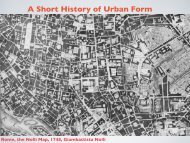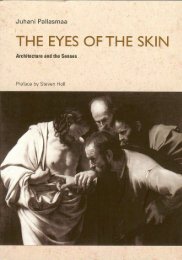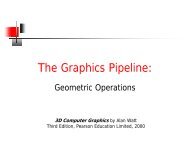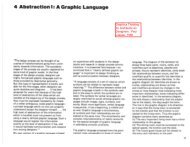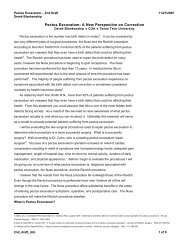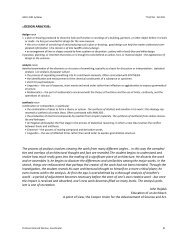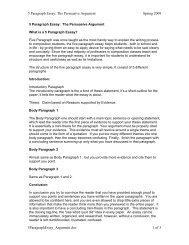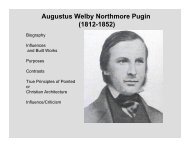Brunelleschi's mirror, Alberti's window, and Galileo's' perspective tube'
Brunelleschi's mirror, Alberti's window, and Galileo's' perspective tube'
Brunelleschi's mirror, Alberti's window, and Galileo's' perspective tube'
- No tags were found...
You also want an ePaper? Increase the reach of your titles
YUMPU automatically turns print PDFs into web optimized ePapers that Google loves.
SAMUEL Y. EDGERTONFigure 3154 História, Ciências, Saúde – Manguinhos, Rio de Janeiro
BRUNELLESCHI´S MIRROR, ALBERTI´S WINDOW, AND GALILEO´S `PERSPECTIVE TUBE´Figure 4v. 13 (suplemento), p. 151-79, outubro 2006 155
SAMUEL Y. EDGERTONFigure 5156 História, Ciências, Saúde – Manguinhos, Rio de Janeiro
BRUNELLESCHI´S MIRROR, ALBERTI´S WINDOW, AND GALILEO´S `PERSPECTIVE TUBE´These simple drawings, dependent as they were on thedraftsmen’s knowledge of linear <strong>perspective</strong> to scale, indicategraphically what this unique Renaissance art technique bequeathedto modern technology, <strong>and</strong> even to modern science, as I shall showan amazing example of shortly. To repeat, linear <strong>perspective</strong> drawingto scale made it possible to invent, improve, <strong>and</strong> correct the mostcomplex machinery without having to waste time <strong>and</strong> moneybuilding <strong>and</strong> testing actual three-dimensional models. No rocketship to the moon could ever have been invented, let alone be built,without the humble heritage of Renaissance linear <strong>perspective</strong>.The rest of my essay will now be devoted to how that remarkable<strong>and</strong> unexpected relationship came about. Indeed, as we shall nowsee, linear <strong>perspective</strong> was first devised with no such scientificapplication in mind, but solely to help solve a very medievaltheological problem, the burgeoning feeling among manyintellectuals of the late Middle Ages that the traditional styles ofreligious painting no longer inspired the faithful sufficiently,especially during a gloomy time when the Holy Mother Churchwas suffering a number of traumatic crises like the loss of Jerusalem<strong>and</strong> the failure of the Christian Crusades, the terrible Schism ofChurch itself, <strong>and</strong> the even more terrible onset of the Black Deathin the fourteenth century. In these miserable times, many peoplethought that God had ab<strong>and</strong>oned them. What was needed in orderto restore the faith, many community leaders <strong>and</strong> churchmen felt,was to make people feel that God <strong>and</strong> his saints were once moreimmanent in their daily lives,Figure 6<strong>and</strong> that people could see <strong>and</strong>touch them just as if theywere actual life-size personsin the here <strong>and</strong> now. Evenfiguratively putting theirfingers in Jesus’ wounds –just as Saint Thomas did – ina famous Florentine statue, soillustrative of this famousBiblical proof (Figure 6), bythe sculptor, Andrea delVerrocchio (ca.1435-1488),teacher of Leonardo da Vinci<strong>and</strong> whose surname, by theway, means ‘True Eye.’Ironically, the currentlypopular early fifteenthcentury“International Style”of painting, even religiouspainting as displayed inv. 13 (suplemento), p. 151-79, outubro 2006 157
SAMUEL Y. EDGERTON3 Antonine, SanctiAntonini SummaTheologica (facsimileof Verona, 1740edition), Graz(Akademische Drucku. Verlagsanstalt),Graz, 1959, 4 vols.This Latin original ofthis text is found in v.3, Titulus 8, Chapter 4,Column 322. See alsothe further discussionof this passage byCreighton Gilbert,1959, p. 75-87.churches, was anything but inspirational. It tended to be frivolous,gaudily colored <strong>and</strong> cluttered with sensual, hardly spiritual trivia,like this well-known altarpiece by Gentile da Fabriano (ca.1370-1427), painted in 1423 (Figure 7). No less than the Dominicanarchbishop of Florence, Fra Antonino Pierozzi (1389-1459), latercanonized as Saint Antonine, spoke out in a public sermon againstsuch painters whose art he disclaimed because they showed“oddities, which do not serve to excite devotion, but laughter <strong>and</strong>vanity, such as monkeys <strong>and</strong> dogs chasing hares, <strong>and</strong> the like, orvain adornment of clothing.” 3Of great interest is that Antonino frequently laced his sermonswith references to a newly arrived science in Italy, actually an oldGreek science related to Euclidian geometry, called in Greekor perspectiva in Latin: the study of how light rays travel in straightlines but always fanning out pyramidally from the light source,<strong>and</strong> how the eye receives these rays <strong>and</strong> thus sees. After the rise ofIslam in the seventh century, this science, now forgotten in theWest, was re-discovered <strong>and</strong> exp<strong>and</strong>ed upon by the Arabs. Onlyafter the slow re-conquest of Moorish Spain <strong>and</strong> Sicily, beginningin the eleventh century, did Western Christians learn of it onceFigure 7158 História, Ciências, Saúde – Manguinhos, Rio de Janeiro
BRUNELLESCHI´S MIRROR, ALBERTI´S WINDOW, AND GALILEO´S `PERSPECTIVE TUBE´more (Lindberg, 1976). By the early fifteenth century, it had spreadto most of the universities of Western Europe, <strong>and</strong> many preachers,especially Antonino, liked to make moral analogies based on perspectivaprinciples (Antonine, op. cit., v. 3, Titulus 9, Chaps. 1-3).But let me stress that this ancient science, which today we call‘optics,’ had as yet nothing to do with the “<strong>perspective</strong> of painting.”It had strictly to do with explaining how light rays enter the eye,how light rays refract when entering a denser medium, <strong>and</strong> how<strong>mirror</strong>s reflect. Then, suddenly some time around 1425, theFlorentine sculptor, engineer, architect, <strong>and</strong> all-around artisanimpresario,Filippo Brunelleschi, painted a small picture of theFlorentine Baptistery to be viewed by looking at its <strong>mirror</strong> reflectionthrough a small hole drilled in the back of the picture with the<strong>mirror</strong> held at arm’s length in front (Figure 8) (Saalman, 1970, p.10-1). A contemporary of Brunelleschi who must have seen theoriginal picture claimed the artist actually discovered his new rulesby applying the same optical geometry that the old science hadlong since divined as to how objects are reflected in <strong>mirror</strong>s (Spencer,1965, v. 2, p. 178v-179r). Unfortunately, this remarkable artworkhas been lost since the mid-fifteenth century. Scholars generallyagree however that it was the first painting in all of world arthistory to have been constructed according to the geometric lawsof what we now underst<strong>and</strong> as artistic ‘linear <strong>perspective</strong>,’ or whatat the time was called perspectiva artificialis to distinguish it fromperspectiva naturalis, the original science of optics.Mirrors in the late Middle Ages were not only objects of scientificoptical study, but were believed to have some sort of divinesignificance. Pilgrims often carried them to sacred shrines in orderFigure 8v. 13 (suplemento), p. 151-79, outubro 2006 159
SAMUEL Y. EDGERTONto capture the reflections of holy relics, the miraculous powers ofwhich were believed to be retained in the <strong>mirror</strong> even when thereflections themselves had disappeared (Schwarz, 1959, p. 90-105).Moreover, earthly reality itself was thought to be only a weakened<strong>mirror</strong> reflection of the perfect reality of heaven. Antonino oftensermonized about the <strong>mirror</strong> as allegory of human mortality,especially as implied in the famous words of St. Paul in his Epistleto the Corinthians (I, 13:12): “videmus nunc per speculum in enigmatatunc autem facie ad faciem” in the Vulgate Latin, which was translatedinto the austere King James English as “For now we see through aglass darkly but then face to face” but which should be moreliterally rendered as, “At present we see things indistinctly, as in a<strong>mirror</strong>, but then face to face.”Brunelleschi’s demonstration indeed permitted viewers to believethat they had penetrated the very enigma of the <strong>mirror</strong>, to see boththe virtual reflection <strong>and</strong> actual Baptistery ‘face to face’ behind thereflection, just as St. Paul had preached. His small h<strong>and</strong>-held panelof the Baptistery astonished fifteenth-century Florentines becauseit revealed not just a superior likeness in the modern secular‘photographic’ sense, but rather because the artist’s <strong>perspective</strong>image seemed to enhance as never before the sacredness of theFlorentine Baptistery. Moreover, Brunelleschi’s viewers were enticedto believe themselves envisioning the very process by which “theprophets see God or his divine mysteries behind the images <strong>and</strong>likenesses of sensible things,” as Antonino preached. “Spiritualgeometry works to measure temporal things … It measures dimensionsnot as quantities but as virtues within God…” (Antonine, op. cit.;see also Edgerton, 1977, v. I, p. 115-30).Nevertheless, the first written connection between art <strong>and</strong> opticalscience was not recorded until 1435, when the humanist-scholar,Leon Battista Alberti (1406-72), stepped literally into the picture.In that <strong>and</strong> the next year, Alberti wrote a book on painting in twoversions: Della pittura in Italian <strong>and</strong> De pictura in Latin, the firstbook to treat the visual arts as an appropriate humanist subject,as worthy of the same intellectual study as the great classics ofantique Greek <strong>and</strong> Roman literature (Alberti, 1972). Alberti, whocertainly accepted without question all the religious analogiesbetween perspectiva naturalis <strong>and</strong> divine intention, neverthelesspreferred to bring the matter more down to earth, as it were. Forhim the real advantage of Brunelleschi’s method was that the veryrigidity of its structure <strong>and</strong> strict adherence to such an absolutelaw of nature as Euclid’s geometry must signify not just divineorder but also human moral order. Alberti was so taken by thefecundity of the arts flourishing in Florence (he dedicated the Italianversion of his book to Brunelleschi) that he now believed thatpainting in particular, if it followed the rules correctly, could provide160 História, Ciências, Saúde – Manguinhos, Rio de Janeiro
BRUNELLESCHI´S MIRROR, ALBERTI´S WINDOW, AND GALILEO´S `PERSPECTIVE TUBE´ethical guidance to noble human behavior just as surely as thewritings of Cicero.Alberti’s actual <strong>perspective</strong> method was no more than acodification of Brunelleschi’s method already in practice by a numberof artists in 1435, but he did present it in the form of simple sequentialsteps which, as his treatise increasingly circulated in Italy <strong>and</strong> acrossthe Alps, helped to proliferate the new art-science throughout Europe(Figure 9). His most original contribution, however, was what hasever since become known as ‘Alberti’s <strong>window</strong>’ (Figure 10), an openframe gridded by perpendicular threads through which the artistshould view the scene to be painted, <strong>and</strong> then transfer the coordinatedetails in scale onto his similarly gridded picture. In essence, even ifinadvertent, it shifted the purpose of <strong>perspective</strong> painting not as adepiction of divine mystery revealed by geometry, but as worldlyperfection framed by geometry.By the early sixteenth century, however, even as Alberti’s<strong>perspective</strong> method was accepted almost everywhere in WesternEurope as providing the ultimate illusion of visual reality in art,Italian painters, while not abjuring the optical truthfulness ofAlberti’s <strong>perspective</strong>, nonetheless began to tire of its geometricrigidity. Furthermore, they were finding new visual excitement increating the illusion not so much of depth but of frontal projection.This new fascination was remarkably encouraged by recentarchaeological discoveries of ancient Roman relief sculpture, whereFigure 9v. 13 (suplemento), p. 151-79, outubro 2006 161
SAMUEL Y. EDGERTONFigure 10figures were carved protruding from the surface of stone or plaster,arranged as if in lateral procession with their forms made visiblenot by painted colors but by the contrast between their lighted<strong>and</strong> shaded sides, <strong>and</strong> the actual shadows they cast against thebackground plane. Instead of simulating a ‘<strong>window</strong>’ view of deepspace beyond the pictorial surface, the ancient carvers created anequally ‘lifelike’ illusion of forward projection. This newarchaeological fascination, especially after the 1520’s, resulted in awidely popular ‘relief-like’ style of classical painting in central Italy(Hall, 1999). Artistic mastery of this novel mode nevertheless stilldepended on knowledge of basic Albertian <strong>perspective</strong> as appliedto the related optical geometry of shadow casting, the laws of whichhad likewise been enumerated by Alberti in his 1435/6 Treatise onPainting.Finally, fast-forwarding to seventeenth-century Florence, nearlytwo hundred years after Brunelleschi’s <strong>mirror</strong> <strong>and</strong> Alberti’s <strong>window</strong>had impressed their profound effects upon European art <strong>and</strong>162 História, Ciências, Saúde – Manguinhos, Rio de Janeiro
BRUNELLESCHI´S MIRROR, ALBERTI´S WINDOW, AND GALILEO´S `PERSPECTIVE TUBE´thought, we encounter Galileo Galilei (1564-1642), the greatastronomer <strong>and</strong> physicist. Not surprisingly, the birth of Galileo innearby Tuscan Pisa on February 15, 1564, just three days beforethe death of the great Michelangelo Buonaroti in Tuscan Florence,has given rise ever since to speculation that there must have beensome kind of occult connection between these two events(Bredekamp, 2000, p. 423-62). For indeed, Galileo, about to becomeas equally revered in science as Michelangelo in art, did seemmysteriously to have inherited a strain of that same artistic talent.Whether or not Galileo’s remarkable ability owed to the abovecoincidence, or just to the fact that for the past three centuriessuch talent seemed almost genetic in the Tuscan population, hisprofound underst<strong>and</strong>ing of linear-<strong>perspective</strong> drawing, calleddisegno in Italian, nonetheless helped mightily to open his eyes tonew revelations of nature that had escaped underst<strong>and</strong>ingeverywhere in the world since the beginning of the human race.Two years before Galileo’s birth, Giorgio Vasari (1511-74), the‘first art historian,’ had founded the Accademia del Disegno (Academyof Drawing) in Florence. This was intended to be an organizationwhere painters, sculptors, <strong>and</strong> architects could meet together notas mere artisan guild-members but as intellectuals, conversingabout current trends in philosophy, literature, <strong>and</strong> science. Vasariwanted to establish a center where artists could keep up to date ongeometry <strong>and</strong> anatomy, the sciences he believed essential to thepractice of the visual arts. Under geometry, he especially stressedthe study of both linear <strong>perspective</strong> <strong>and</strong> chiaroscuro, literally ‘lightdark,’the rendering of shades <strong>and</strong> shadows. The Academy shouldeven provide for a professional geometer to teach these subjects toless-prepared artist-members. In 1588, the 24-year-old Galileoconsidered himself sufficiently trained in the art-science of disegnoto apply for this position. While there is no record that he wasoffered the job, it was perhaps during this period that the aspiringyoung teacher began his lifelong friendship with the painterLodovico Cardi, called Cigoli (1559-1613), five years older <strong>and</strong>already a member. Cigoli lauded Galileo’s knowledge of geometry,even acknowledging that in <strong>perspective</strong> drawing, Galileo was his‘master’ (ibid.). Galileo’s increasing competence in this skill ledfinally, in 1613, to his own election to the prestigious Accademia.In 1612, Cigoli found himself embroiled in one of those endlessRenaissance debates over which was superior, painting or sculpture,<strong>and</strong> asked his friend for support. Galileo replied that painting issurely the superior art because it imitates what is visible but notimmediately tangible:The statue does not have its relief by virtue of being wide, long,<strong>and</strong> deep but by virtue of being light in some places <strong>and</strong> dark inv. 13 (suplemento), p. 151-79, outubro 2006 163
SAMUEL Y. EDGERTONothers. And one should note as proof of this, that only two of itsthree dimensions are actually exposed to the eye: length <strong>and</strong> width(which is the superficies ... that is to say, periphery or circumference).For, of the objects appearing <strong>and</strong> seen we see nothing but theirsuperficies; their depth can not be perceived by the eye because ourvision does not penetrate opaque bodies. The eye then sees onlylength <strong>and</strong> width <strong>and</strong> never thickness. Thus, since thickness isnever exposed to view, nothing but length <strong>and</strong> width can beperceived by us in a statue. We know of depth, not as a visualexperience per se <strong>and</strong> absolutely but only by accident <strong>and</strong> inrelation to light <strong>and</strong> darkness. And all this is present in paintingno less than in sculpture ... But sculpture receives lightness <strong>and</strong>darkness from Nature herself whereas painting receives it fromArt... (Panofsky, 1956, p. 32-7)Galileo apparently cared little for the abstract vagaries of theMannerist style as recently practiced by certain artists in his nativecity, preferring the classically based volumetric, more or lessuncolored chiaroscuro painting advocated by the Accademia del Disegno– in fact, the favored style of Leon Battista Alberti. I must also addthat, by the late sixteenth century, the study of linear <strong>perspective</strong>in general <strong>and</strong> chiaroscuro in particular appealed not only to artistsbut ever more to professional scholars especially in Italy <strong>and</strong>Germany who otherwise had no interest in the visual arts. Numbersof highly technical <strong>perspective</strong> books were printed with thisaudience in mind. In Italy, prestigious mathematicians like FedericoComm<strong>and</strong>ino <strong>and</strong> his student Guidobaldo del Monte bothpublished on the subject. Comm<strong>and</strong>ino was the first professionalgeometer to discuss linear <strong>perspective</strong> <strong>and</strong> introduce its pictorialconventions to theoretical mathematics.Guidobaldo del Monte was to become one of Galileo’s strongestsupporters, helping the young scientist to find his initial teachingjob at the university of Pisa in 1589, <strong>and</strong> his second at the universityof Padua in 1592. Guidobaldo’s treatise, Perspectivae libri sex,published in Pesaro, 1600, contained a whole section on castshadows <strong>and</strong> would surely have been studied by Galileo. Figure11 shows one of Guidobaldo’s woodcut illustrations of varioussolids under raking light, indicating how they cast their shadowson a plane. As a perspectivist, Galileo would likely have been familiarwith Daniel Barbaro’s La pratica della perspettiva, published in severaleditions in Venice during the late 1560s, <strong>and</strong> often consulted bymembers of the Florentine Accademia. Barbaro offered a number ofdifficult drawing exercises including how to draw spheres withraised protuberances, <strong>and</strong> how these would then receive light <strong>and</strong>cast shadows on a curving surface. If Galileo were not familiarwith Barbaro, he most certainly studied another similar work alsoentitled La pratica di prospettiva, by Lorenzo Sirigatti in 1596. The164 História, Ciências, Saúde – Manguinhos, Rio de Janeiro
BRUNELLESCHI´S MIRROR, ALBERTI´S WINDOW, AND GALILEO´S `PERSPECTIVE TUBE´Figure 11latter was himself a charter member of the Accademia <strong>and</strong> cavalierein the court of Gr<strong>and</strong> Duke Ferdin<strong>and</strong> de Medici. This h<strong>and</strong>somelypublished treatise consisted of two sections, the first giving st<strong>and</strong>ardinstruction in how to project multi-faceted solids <strong>and</strong> the second av. 13 (suplemento), p. 151-79, outubro 2006 165
SAMUEL Y. EDGERTONseries of twenty-four plates illustrating special problems of chiaroscuro,including several remarkable engravings of shaded spheres withboth raised protuberances <strong>and</strong> recessed channels (Figure 12).Let us for a moment take leaveFigure 12of Florence <strong>and</strong> look in on JacobeanLondon during the summer of1609, where we encounter Galileo’sscientific contemporary, ThomasHarriot (1560-1621), who has justprocured a fascinating newinstrument invented the yearbefore in Holl<strong>and</strong>, which he calleda ‘<strong>perspective</strong> tube,’ <strong>and</strong> which, ofcourse, we now call the telescope.The Dutch inventors had thoughtthat the new device would be mostuseful to sailors for spottingdistant ships at sea, or to militarycomm<strong>and</strong>ers for discerning far-offenemy installations, but Harriotdid the novel thing of turning iton the moon. He even made anextant drawing of the moon asseen through his ‘<strong>perspective</strong> tube’(Figure 13). Unfortunately, he added no explanation save the (Juliancalendar) date <strong>and</strong> time of his observation: “1609, July 26,hor.9p.m.,...The [first quarter] 5 dayes old.” In any case – <strong>and</strong> thereason why he is hardly remembered in the history of astronomy– Harriot’s crude sketch reveals nothing new.Europeans of his time still had no reason to doubt Aristotle’sdefinition of the moon as a perfect sphere, the prototypical form ofall planets <strong>and</strong> stars in the cosmos. Christian doctrine added tothis euphoric image by having the moon symbolize the Virgin’sImmaculate Conception. ‘Pure as the moon’ became a commonplaceexpression for Mary, implying that the universe, like her, wasincorruptible, that God would not have created the moon or anyheavenly body in another shape. Renaissance artists, especially thoseserving zealous Catholic patrons, frequently depicted the Virginst<strong>and</strong>ing on such a moon, as did Bartolomé Estabán Murillo (1617-82) well into the seventeenth century, especially in Spain (Figure 14). Wesee her here in one of many paintings Murillo did of the subject,poised upon a ball marbled like translucent alabaster but with ahighly polished, utterly smooth surface.In Thomas Harriot’s Engl<strong>and</strong>, anti-Aristotelian Francis Bacon(1561-1626) had concluded that the lunar body was not solid atall, but rather composed of some unexplained ‘vapour.’ Harriot’s166 História, Ciências, Saúde – Manguinhos, Rio de Janeiro
BRUNELLESCHI´S MIRROR, ALBERTI´S WINDOW, AND GALILEO´S `PERSPECTIVE TUBE´Figure 13own opinion about the moon’s composition remains unrecorded.Nonetheless, he drew the terminator, that is, the demarcation linebetween the illuminated <strong>and</strong> shaded portions of the moon, withshort, ragged strokes as if it fell over a roughened surface. On theupper half of the sphere, Harriot indicated the configurations ofwhat we now know as the great lunar ‘seas,’ the Maria Tranquilitatis,Crisium, <strong>and</strong> Serenitatis, which do seem to have appeared to him assurface markings rather than internal, vaporous discolorations.Nevertheless, he was unable to recognize the significance ofthese observations. His ‘<strong>perspective</strong> tube’ only confirmed more orless what the ancients had always said he would see. The “strangespottednesse of the moon,” as Harriot called the phenomenon,remained as mysterious to him as ever.Later in the same year, 1609, Galileo built himself a similartelescope, based only on news of its prior invention in theNetherl<strong>and</strong>s, but with no knowledge of Thomas Harriot. Galileo’sown home-made ‘<strong>perspective</strong> tube’ was in effect no more than‘Alberti’s <strong>window</strong>’ enhanced by magnifying lenses. He too aimed itat the moon, <strong>and</strong> as he evaluated what he observed, his own<strong>perspective</strong> drawing experience made it clear to him that Harriot’s‘strange spottednesse’ was really dark shadow cast by protrudingmountains on the moon’s irregular surface. To the startled publicwho read his book, Sidereus nuncius (Starry Messenger) in 1610,Galileo’s ‘<strong>perspective</strong> tube’ quite shattered ‘Brunelleschi’s <strong>mirror</strong>.’v. 13 (suplemento), p. 151-79, outubro 2006 167
SAMUEL Y. EDGERTONFigure 14What Galileo’s version of ‘Alberti’s <strong>window</strong>’ revealed was that theearth was not necessarily a pale reflection of the immaculate heavensas ‘Brunelleschi’s <strong>mirror</strong>’ proclaimed, but in the case of the moonjust the other way around. Beyond any Jesuit doubt, that is, if oneof them dared to look through his ‘<strong>perspective</strong> tube,’ Galileo provedthat the first ‘planet’ in Dante’s magnificent ascent to the heavenlyEmpyrion was hardly the ‘eternal pearl’ described by the poet, butrather a most imperfect sphere, marred <strong>and</strong> crinkled just like thelowly earth.Why did Thomas Harriot miss what Galileo saw so preciselyjust a few months later? Was it only because his telescope was less168 História, Ciências, Saúde – Manguinhos, Rio de Janeiro
BRUNELLESCHI´S MIRROR, ALBERTI´S WINDOW, AND GALILEO´S `PERSPECTIVE TUBE´powerful than Galileo’s? To the latter question, I answer no, becausethe moon through any ‘<strong>perspective</strong> tube’ of the time could hardlyhave looked as sharp as it does in a modern Lick Observatoryphotograph familiar to every college astronomy student (Figure 15).Both Galileo’s <strong>and</strong> Harriot’s instruments, mounted on ricketyhome-made stanchions, must have been difficult to focus to saythe least. Moreover, such primitive devices had very narrow fieldsof view; only about a quarter of the moon could be observed atone time (van Helden, 1974, p. 44). In sum, neither the English northe Tuscan scientist could have seen the moon so distinctly that itstrue surface topography would be instantly self-evident. Besides,quite a number of such ‘tubes’ were being produced in severalcenters of Europe by the end of 1609. Would not someone else alsoFigure 15v. 13 (suplemento), p. 151-79, outubro 2006 169
SAMUEL Y. EDGERTONhave thought to aim the instrument toward the sky? If one knewnothing a priori about the moon’s external topography, would itsgrayish blotches be seen immediately as shades <strong>and</strong> shadows ofmountain ridges? Especially if the observer, like all people before1610, was already certain such blotches had something to do withthe moon’s translucent internal composition?Perhaps Galileo surely made some illustrations right there onthe spot as he stared at the moon from atop the San GiorgioMaggiore campanile in Venice. While none of these have survived,we are in possession of seven finished sepia studies, which I believewere done later, based on his first ad hoc sketches. These smallfinished wash drawings, four of the waxing <strong>and</strong> three of the waningmoon, are still preserved on two sides of a sheet of artist’s water-colorpaper in the Biblioteca Nazionale in Florence (Figure 16). All werecertainly done by someone well-practiced in the manipulation ofFigure 16170 História, Ciências, Saúde – Manguinhos, Rio de Janeiro
BRUNELLESCHI´S MIRROR, ALBERTI´S WINDOW, AND GALILEO´S `PERSPECTIVE TUBE´4 There is no wayGalileo could havemade such carefulpen-<strong>and</strong>-wash studiesduring his excitingfirst moments at thetelescope, as anyonewho has ever stood inthe cold, windswepttower of San GiorgioMaggiore (Galileo’sopen ‘observatory’)should quicklyunderst<strong>and</strong>. Like anyseventeenth-century‘l<strong>and</strong>scape painter,’Galileo returned to thestudio to finish hispictures, based onrememberedimpressions, verbalnotes, <strong>and</strong> hastydiagrams. Plein airpainting, after all, wasnot invented until thenineteenth century.ink washes, especially the rendering of chiaroscuro effects. They areby an experienced artist, <strong>and</strong> we have no reason to believe byanyone other than Galileo himself.Galileo no doubt prepared these washes as models for theengraver who would illustrate his book, Sidereus nuncius, which herushed to publication barely five months after he began looking atthe skies through his home-made telescope. Only five engravingsof the moon’s phases were printed in Sidereus nuncius, none exactlyreplicating the wash drawings. 4 Figure 17 indicates how two ofthese appeared in Galileo’s book.Figure 17Figure 18 is another Lick Observatory photograph showingthe same second-quarter waxing Moon as illustrated at left in Sidereusnuncius. Galileo’s accompanying matter-of-fact textual descriptionof these engravings belies both his own excitement <strong>and</strong> thestupendous impression they made upon an unsuspecting world:[I] have been led to the conclusion that … the surface of theMoon is not smooth, even, <strong>and</strong> perfectly spherical, as the greatcrowd of philosophers have believed about this <strong>and</strong> otherheavenly bodies, but, on the contrary, to be uneven, rough, <strong>and</strong>crowded with depressions <strong>and</strong> bulges. And it is like the face of theEarth itself, which is marked here <strong>and</strong> there with chains ofmountains <strong>and</strong> depths of valleys. (Galileo, 1989, p. 40)v. 13 (suplemento), p. 151-79, outubro 2006 171
SAMUEL Y. EDGERTONFigure 18As stated, the illustrations in Sidereus nuncius are not exact copiesof any of the wash drawings. It would seem that Galileo furnishedthe latter only as guides to the engraver, who was apparently askedto emphasize the more spectacular features of the moon’s surface. Heeven permitted the engraver a certain artistic license to exaggeratethe size of that particularly dark, deep crater we see lying just belowcenter along the terminator in Figure 17. This is Albategnius, <strong>and</strong>Galileo wished to compare its steep sides to the high mountainson Earth surrounding the region of Bohemia. Thus he bade hisengraver to render it large, to dramatize that the moon is coveredall over with such rugged depressions. We should also bear inmind that the engraver would probably not have looked throughthe telescope himself, but depended solely on the astronomer’sdrawings <strong>and</strong>, no doubt, Galileo’s rather excited verbal descriptions.Galileo’s original wash drawings reveal a much more ‘painterly’lunar surface than do the published engravings. Most modern172 História, Ciências, Saúde – Manguinhos, Rio de Janeiro
BRUNELLESCHI´S MIRROR, ALBERTI´S WINDOW, AND GALILEO´S `PERSPECTIVE TUBE´historians have talked about only the latter, which by virtue oftheir metallic, linear technique, make Galileo’s moon look like thearid <strong>and</strong> lifeless body our modern astronauts discovered it to be. Hiswash renderings, on the other h<strong>and</strong>, show that he still regardedthe Moon somewhat in the old medieval ‘watery’ spirit. With thedeft brushstrokes of a practiced water-colorist, he laid on ahalf-dozen different grades of washes, imparting to his images anattractive soft <strong>and</strong> luminescent quality. Remarkable indeed wasGalileo’s comm<strong>and</strong> of the Baroque painter’s convention forcontrasting lighted surfaces, <strong>and</strong> his ability to marshal darks <strong>and</strong>lights to increase their mutual intensities. In the upper left of thesheet of sepia drawings, in Figure 16, we see how he set down alittle practice patch of dark <strong>and</strong> light washes surrounding a whitearea, probably to help his engraver realize the form of the lunarcrater as it took shape in the waxing light. With artistic economyworthy of Tiepolo, Galileo indicated the concave hollow with asingle stroke of dark, leaving a sliver of exposed white paper torepresent the crater’s glowing brim.Is it preposterous to claim that these simple, yet highlyprofessional paintings belong as much to the history of art as theydo to the history of science? While no comparable art work existsalso attributable to Galileo, we do have much contemporary verbaltestimony concerning his considerable skill as a draftsman. In thetrue spirit of the Florentine Accademia, Galileo seems to have engagedin disegno not for the sake of self-expression but rather to disciplinehis eye <strong>and</strong> h<strong>and</strong> for science. And yet he has at the same time inthese chiaroscuro washes anticipated the independent l<strong>and</strong>scape inthe history of art. His almost impressionistic technique for renderingfleeting light effects reminds us of Constable <strong>and</strong> Turner, <strong>and</strong>perhaps even Monet. One needs only to read on in Sidereus nunciusto appreciate his wonder, as well as his rational underst<strong>and</strong>ing ashe gazed upon the transient moonscape, noticing it was coveredwith small spots having:their dark part on the side toward the Sun, while on the sideopposite the sun they are crowned with brighter borders likeshining ridges. And we have an almost entirely similar sight onEarth, around sunrise, when the valleys are not yet bathed inlight but the surrounding mountains facing the Sun are alreadyseen shining with light. And just as the shadows in the earthyvalleys are diminished as the Sun climbs higher, so these lunarspots lose their darkness as the luminous part grows. Not onlyare the boundaries between light <strong>and</strong> dark on the Moonperceived to be uneven <strong>and</strong> sinuous, but what causes evengreater wonder is that many bright points appear within thedark part of the Moon, entirely separated <strong>and</strong> removed from theilluminated region <strong>and</strong> located no small distance from it.v. 13 (suplemento), p. 151-79, outubro 2006 173
SAMUEL Y. EDGERTONGradually after a small period of time, these are increased insize <strong>and</strong> brightness. Indeed, after 2 or 3 hours they are joinedwith the rest of the bright part, which has now become larger. Inthe meantime, more <strong>and</strong> more bright points light up, as if theyare sprouting, in the dark part grow, <strong>and</strong> are connected at lengthwith that bright surface as it extends farther in that direction …Now on Earth, before sunrise, aren’t the peaks of the highestmountains illuminated by the Sun’s rays while shadows stillcover the plain? Doesn’t light grow, after a little while, until themiddle <strong>and</strong> larger parts of the same mountains are illuminated,<strong>and</strong> finally, when the Sun has risen, aren’t the illuminations ofplains <strong>and</strong> hills joined together? (Ibid., p. 41-3)Did ever a Baroque painter express the new secular spirit ofl<strong>and</strong>scape art better than this? Was ever an artist’s eye betterprepared to recognize the universal geometrical principles of<strong>perspective</strong> optics <strong>and</strong> chiaroscuro even at work on the moon?Moreover, after thus having marveled at the picturesque lunarterrain, Galileo quickly reverted to his scientific self <strong>and</strong> made twoother amazing <strong>perspective</strong>-related discoveries. The first was whenhe noticed that some of the lunar peaks were tipped with lightwithin the shadow side even as the terminator boundary lay along way off. At the same time, he was able to convert thisphenomenon into a geometric diagram for solving a shadow-castingproblem such as he may have recalled from Guidobaldo del Monte.Figure 19 illustrates another manuscript page which Galileoprepared for Sidereus nuncius. On it he drew a circle representingthe moon, divided by the terminator, which he marked cef. TheSun’s shadow-casting light rays he indicated by the tangent linedcg. With particular ingenuity, considering that his primitivetelescope had no cross-hair sighting device, he was able to estimatethe real distance of the lighted lunar mountain peak to the terminatoras being about one-twentieth (line dc here in the diagram) of theMoon’s whole diameter. This distance, more or less comparable toline DK in Guidobaldo del Monte’s cone/shadow diagram (Figure11), then allowed him to triangulate the mountain’s height. Sincethe moon’s diameter was known to be two-sevenths of the Earth’sown diameter, or about two thous<strong>and</strong> miles, Galileo’s triangle ced,with ce equaling one thous<strong>and</strong> miles, <strong>and</strong> cd one hundred, revealedby Pythagorean calculation that da, the mountain’s height on centerfrom its base, reached more than four miles into the lunar sky! Byapplying a problem well known to students of Renaissance<strong>perspective</strong>, Galileo added yet another fact to his already wondrousrevelations, that the mountains on the moon were more spectacularthan the Alps here on Earth.Galileo’s telescopic observations of the moon, announced inSidereus nuncius, opened the eyes of Renaissance Europeans to a174 História, Ciências, Saúde – Manguinhos, Rio de Janeiro
BRUNELLESCHI´S MIRROR, ALBERTI´S WINDOW, AND GALILEO´S `PERSPECTIVE TUBE´Figure 19celestial reality they had never before imagined. If Thomas Harriot’sBritain still lingered in the pre-<strong>perspective</strong> Middle Ages, Galileooffered that insulated l<strong>and</strong> a crash course in Italian ways ofseeing. Suddenly, everywhere in Britain, amateur as well asprofessional philosophers were able to conceive of the same“mountains <strong>and</strong> umbrageous dales” as Galileo had just described,whatever the quality of their own telescopes. The l<strong>and</strong>scaped moonas well as the ‘<strong>perspective</strong> glasse’ became instant metaphors in thewritings of Dryden, Donne, Butler, Milton, <strong>and</strong> many other Britishv. 13 (suplemento), p. 151-79, outubro 2006 175
SAMUEL Y. EDGERTON5 Even in ProtestantEngl<strong>and</strong>, John Donne(1572-1631), when heheard of Galileo’sdiscoveries,suspected (withtongue in cheek) thatit was all a Jesuit plotanyway (as he wrotebelow in his fiercelysatirical tract, ‘Ignatiushis Conclave’ in1611): “I will write theBishop of Rome: heshall call Galileo theFlorentine who by thistime hath thoroughlyinstructed himself ofall the hills, woods,<strong>and</strong> cities in themoon. And nowbeing grown to moreperfection in his art,he shall have madenew glasses, <strong>and</strong> withthese having receiveda hallowing from thepope, he may drawthe moon, floating likea boat upon the water,as near the Earth as hewill. And thither(because they everclaim that thoseemployments ofbelong to them) shallthe Jesuites betransferred, <strong>and</strong> easilyunite <strong>and</strong> reconcilethe Lunatique Churchto the Roman Church.And without doubt,after the Jesuites havebeen there a littlewhile, there will soongrow naturally a Hellin that world, overwhich you [?] IgnatiusLoyola shall havedominion...”.poets. 5 Even Harriot, once he had read Sidereus nuncius, finally ‘saw’the shaded craters which had eluded him a year before. In July of1610, four months after Sidereus nuncius was published, Harriot drewyet another lunar picture (Figure 20).Again, there is no written comment, but the Englishman didsketch the moon’s concavities in pen-stroke circles <strong>and</strong> half-circles,even exaggerating Albategnius in imitation of the Sidereus nunciusengraver’s drawing. It is a curious fact, if only a coincidence, thatin 1611, hardly a year after Engl<strong>and</strong> received Galileo’s stunningannouncement, Inigo Jones, the first Englishman to have talent<strong>and</strong> training in the conventions of Italian <strong>perspective</strong> drawing,was appointed Surveyor General to the Prince of Wales, <strong>and</strong>Sebastiano Serlio’s “Treatise on Architecture,” the most widely readtextbook on the neo-classical style – including a special section onlinear <strong>perspective</strong> – was translated into English. Both events,following immediately upon the news of Galileo’s telescopicFigure 20176 História, Ciências, Saúde – Manguinhos, Rio de Janeiro
BRUNELLESCHI´S MIRROR, ALBERTI´S WINDOW, AND GALILEO´S `PERSPECTIVE TUBE´discoveries, signaled the arrival finally of the full-blown ItalianRenaissance to the British Isles.There still remained, of course, some recalcitrant souls who sofirmly believed the moon was ‘pure’ that they could not be persuadedto look through Galileo’s telescope. The Roman Catholic Church,however, was quick to co-opt the new discovery. In 1612, Galileo’sfriend Cigoli the painter was commissioned to fresco the domedceiling of the Pauline Chapel in the Basilica of Santa Maria Maggiorein Rome. The artist was permitted to depict there the Virgin Maryst<strong>and</strong>ing on a crater-pocked Moon, no doubt inspired by one ofGalileo’s original drawings (Figure 21) (Ostrow, 1996, p. 218-35).To this day Cigoli’s painting is officially <strong>and</strong> prudently calledthe Assumption rather than the Immaculate Conception. By thisadmission in such a sacred place, the Church tacitly acknowledgesthat Galileo was not altogether wrong about at least some of theheavens looking just like Earth.Figure 21v. 13 (suplemento), p. 151-79, outubro 2006 177
SAMUEL Y. EDGERTONIt is worth noting in conclusion, however, that as astronomersafter Galileo dem<strong>and</strong>ed to see ever more distant planets <strong>and</strong> stars,the <strong>perspective</strong> tube had to be extended longer <strong>and</strong> longer withmagnifying lenses larger <strong>and</strong> larger. Finally, no less than Sir IsaacNewton (born the same year Galileo died) realized that anotheroptical component must be added to the instrument to increase itspower. In order to reveal ever more of the great beyond stillshrouded in enigmata, ‘Alberti’s <strong>window</strong>’ cum telescope needed to befurther enhanced by reinstalling ‘Brunelleschi’s <strong>mirror</strong>’ (Figure 22).Figure 22REFERENCESAlberti, Leon Battista On painting <strong>and</strong> sculpture: the latin texts of De Pictura <strong>and</strong> De Statua.1972 Transl. & notes by Cecil Grayson. London & New York: Phaidon Press.AntonineSancti Antonini Summa Theologica. Facsimile of Verona, 1740 edition.1959 Graz: Akademische Druck u. Verlagsanstalt. 4 v.Bredekamp, Horst Gazing h<strong>and</strong>s <strong>and</strong> blind spots: Galileo as draftsman.2000 Science in context, v. 13, n. 3-4, p. 423-62.Edgerton, Samuel Y. The heritage of Giotto’s geometry: art <strong>and</strong> science on the eve of the1991 scientific revolution. Ithaca (NY) & London: Cornell University Press.p. 125-39.Edgerton, Samuel Y. Mensurare temporalia facit Geometria spiritualis: some fifteenth-century1977 italian notions about when <strong>and</strong> where the Annunciation happened.In: Lavin, Irving; Plummer, John (ed.) Studies in late medieval <strong>and</strong> renaissancepainting in honor of Millard Meiss. New York: New York University Press.v. I, p. 115-30.178 História, Ciências, Saúde – Manguinhos, Rio de Janeiro
BRUNELLESCHI´S MIRROR, ALBERTI´S WINDOW, AND GALILEO´S `PERSPECTIVE TUBE´Galileo GalileiSidereus nuncius or The Sidereal Messenger. Transl. by Albert Van Helden.1989 Chicago: University of Chicago Press, p. 40.Gilbert, Creighton The Archbishop on the Painters of Florence.1959 The Art Bulletin, v. 41, p. 75-87.Hall, Marcia B.After Raphael: painting in Central Italy in the sixteenth century.1999 Cambridge (UK): Cambridge University Press.Lindberg, David C. Theories of vision from Al-Kindi to Kepler.1976 Chicago & London: University of Chicago Press.Ostrow, Stehen Cigoli’s Immaculata <strong>and</strong> Galileo’s Moon: astronomy <strong>and</strong> the Virgin in early1996 Seicento Rome. The Art Bulletin, v. 78, n. 2, p. 218-35.Panofsky, Erwin Galileo as critic of the arts; aesthetic attitude <strong>and</strong> scientific thought.1956 The Hague: Martinus Nijhoff. p. 32-7.Saalman, Howard (ed.) The life of Brunellschi by Antonio di Tuccio Manetti.1970 Transl. by Catharine Enggass. University Park (PA) & London:Pennsylvania State University Press. p. 10-1.Schwarz, Heinrich The Mirror of the Artist <strong>and</strong> the Mirror of the Devout. Studies in the history1959 of art dedicated to William E. Suida on his eightieth birthday.London & New York: Phaidon Press. p. 90-105.Spencer, John R. Filarete’s Treatise on Architecture: being the treatise by Antonio di Piero Averlino(transl. & ed.)Known as Filarete. New Haven & London: Yale University Press.1965 v. 2, p. 178v-179r.van Helden, Albert The telescope in the seventeenth century.1974 Isis, v. 65, p. 44.Submitted on October 2005.Approved on February 2006.v. 13 (suplemento), p. 151-79, outubro 2006 179



